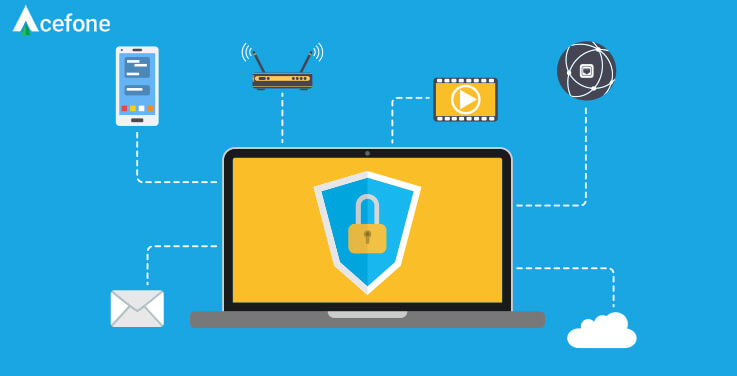Cloud cryptography uses encryption techniques that protect the data stored within the cloud. It protects your data from cloud operators, ensuring that it isn’t manipulated or saved on unauthorised servers.
To prevent this breach of data, cryptography in the cloud employs encryption techniques that allow users to access cloud services securely. The data hosted is safeguarded and helps protect sensitive data without delaying the delivery of information.
There are majorly two methods used to code and decode the data:
- Symmetric algorithm – In this algorithm, the encryption and decryption keys are the same. It is primarily used for bulk data encryption and is suitable for both closed systems and individual users.
- Asymmetric algorithm – In this algorithm, two different keys are used (public and private). The keys are not alike but paired with each other. The private key is kept secret, and you can share the public key with anyone.
How does cloud cryptography work?
Cloud cryptography uses encryption techniques in which algorithms scramble text into a code known as ciphertext. With the help of an encryption key, you can change ciphertext into plaintext by decoding it with a series of bits. With access to cryptographic keys, anyone can retrieve the servers with ease and safety. Encryption can secure three types of data.
- Information at rest – When data is being stored electronically through the cloud. Example mobile devices, computer hard drives, etc.
- Information in transmits – When information is being moved through connections online. Example applications, emails, browsers, etc.
- Information in use – When one or more applications are processing data and it is not stored in any external storage device such as a hard drive.
Data encryption takes place in the following ways.
- Full disk encryption – It is a cryptographic method that safeguards the data on your computer’s hard drive including program files and operating system. It protects all the files saved on the hard drive and automatically encrypts any file saved in the external drive or on the hard disk.
- End-to-end description – In this cryptographic method, we can secure data at both ends of the communication. It prevents third parties from accessing it while being transferred from one system to another. It is the most secure way to communicate online. Example: Facebook messenger
- File encryption – In this cryptographic method, data is being encrypted within the file and can be decrypted only with the correct password or an encryption key. So any unauthorised person who tries to intercept the file would not be able to access the information.
- Pre-encrypted data synced with the cloud – In this cryptographic method, data is being pre-encrypted before transferring to the cloud. It prevents hackers and anyone with malicious intent from reading or accessing the data.
Cloud encryption, security, and crypto management
Cloud encryption is the simplest way to avoid the breach of data. Different companies implement data security solutions and techniques to protect sensitive data through cryptographic key management.
Due to the COVID-19 pandemic, more and more companies are investing in cloud computing services. While cloud services do improve the efficiency of an organisation, they are also susceptible to cyberattacks. To prevent such attacks, better encryption techniques and authentication tools are used, which would prevent hackers from exploiting a weakness in the cloud computing system.
Some companies choose to encrypt data before uploading it, while others encrypt data upon receipt.
Role of cloud cryptography in securing content
Cloud cryptography plays a significant role in securing content within the cloud by encryption techniques and safeguarding the data against online threats. It also issues cryptography keys that allow users to access the data. Anyone who does not have the key will not access the data and keeps it safe from unauthorised users.
An excellent way to protect data is to store it cryptographically with users maintaining control of the keys. Two types of encryption methods are
- Symmetric encryption – In symmetric encryption, one key (secret) is used to encrypt and decrypt data. In this method, one can convert data into a form that is not readable for external parties. Anyone who has the cryptographic key would be able to decrypt the message into a readable format. In order to communicate via symmetric encryption method, one would need to exchange cryptographic keys.
- Asymmetric encryption – In asymmetric encryption, two keys (public and private) are used to encrypt and decrypt data. These cryptographic keys are separate but are mathematically connected. The private key is kept secret or hidden, while you can share the public key with anyone.
Security in the cloud using cryptographic techniques
Security in cloud computing depends on different factors, including what type of encryption method is used, what type of key is used to encrypt or decrypt data, the key length, and type of data being encrypted, etc.
Some of the most common cryptographic techniques are –
- Advanced encryption standard (AES) – It is the most commonly used symmetric algorithm. It is used to encrypt a fixed block of data (128 bits). To decipher the text, the keys may be -128, -192, and -256 bit long.
- Rivest Shamir Adleman (RSA) – RSA is an asymmetric algorithm that generates a pair of keys. You can share the public key while the private key is kept as a secret. These keys are numerically linked together and generated via a one-way function.
- Triple Data Encryption Standard (TripleDES) – TripleDES is a symmetric encryption technique in which three instances of double encryption standard are used on the same plain text. It is used to encrypt ATM pins and UNIX passwords.
- Twofish – Twofish is a symmetric key block cypher which blocks data of 128 bits. It works slower than the advanced encryption standard (AES) and encrypts data in 16 rounds irrespective of the key’s size.
Wrapping up
Cloud cryptography uses encryption techniques that prevent the breach of data and keeps your content safe. Cryptography in the cloud issues encryption keys, thus limiting the number of people who access the data. Hackers and users with malicious intent would not be able to access the data without the keys.
Get in touch with us at 1888-859-0450 or send an email to [email protected] anytime to get started with cloud solutions.














